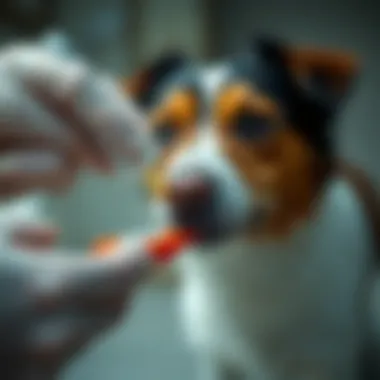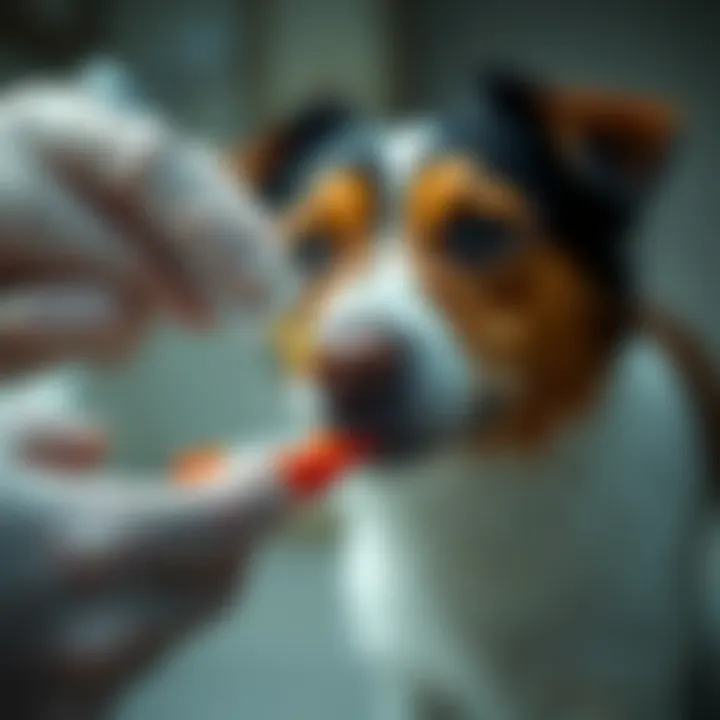Effective Vet-Recommended Flea Treatments for Dogs


Intro
Flea infestations can be more than just a pesky nuisance for dogs and their owners. They can lead to discomfort, skin infections, and even more serious health complications if left untreated. Pet owners are often caught in a maze of options when it comes to flea treatment products. With the myriad of treatments on the market, how does one sift through the noise to find what truly works? This article seeks to distill the wisdom of veterinarians, exploring recommended options for flea control tailored to the unique needs of dogs. By understanding the landscape of treatments, as well as their effects and application, dog owners can make informed decisions to keep their furry companions healthy and comfortable.
Pet Care and Grooming
When tackling flea infestations, it’s essential to consider the whole picture of pet care, which begins with grooming. Regular grooming not only prevents fleas but also builds a bond between pet and owner.
Importance of Regular Care
Regular grooming serves several purposes. It helps identify any flea activity early. Furthermore, a consistent grooming routine can improve your dog’s skin health, minimize shedding, and enhance their coat’s appearance. Fleas like to hide, so a thorough brush can provide early insights into any issues.
Grooming Techniques by Pet Type
Different breeds come with various grooming needs. For instance, long-haired breeds like Golden Retrievers or Afghan Hounds require regular brushing, while short-haired breeds like Beagles might need less frequent grooming but still benefit from regular check-ups for fleas and ticks.
Tools and Products Recommendations
Several tools can assist pet owners in an effective grooming process:
- Flea comb: A fine-toothed comb designed to capture fleas and their eggs.
- Grooming gloves: These help collect dander and loose hair while allowing petting and bonding.
- Deshedding tools: Useful for breeds that shed excessively, reducing the risk of finding fleas in loose fur.
- Mild, vet-approved shampoos: Helps in controlling flea populations during grooming. Look for products containing natural ingredients to be safe for your dog’s skin.
Seasonal Care Tips
Fleas thrive in warm, humid conditions. To combat them effectively, be aware of the seasons that are most likely to harbor these pests. In warmer months, consider increasing your dog’s grooming sessions. In colder months, don’t become complacent; fleas can survive indoors where it’s warm.
By incorporating thorough grooming techniques into your pet care routine, you can not only enhance your dog's health but also keep flea infestations at bay. Regular grooming establishes a strong line of defense, setting the stage for exploring specific flea treatments.
Health and Nutrition
Understanding your dog's overall health and nutrition is paramount in maintaining their flea control regimen. Dogs with strong immune systems are less prone to heavy infestations or secondary infections caused by fleas.
Understanding Pet Nutrition
A balanced diet rich in vitamins and minerals helps to bolster the immune system. Ingredients like Omega-3 fatty acids can impact skin health, making it less hospitable for fleas. When selecting dog food, always look for high-quality ingredients.
Common Health Issues by Species
Fleas can exacerbate existing health issues such as allergies and skin sensitivities. Dogs with compromised immune systems might struggle more when dealing with a flea infestation, leading to more severe health consequences. These include anemia or flea allergy dermatitis, which could require immediate veterinary attention.
Preventive Care and Regular Check-Ups
Regular veterinary check-ups are critical. Flea preventatives, like topical treatments or oral medication, can provide an extra layer of protection. Make it a habit to ask your vet about the best options tailored to your dog's health and lifestyle.
Food and Dietary Advice
Choosing the right food can enhance your dog's overall health. Consult with your veterinarian to find the most suitable diet based on your dog's size, age, and any medical concerns. Consider asking about specialized diets that incorporate flea-repelling nutrients.
Behavioral Training
It's also important to manage a dog's overall behavior, as stress can impact their health. A calm and happy dog is less likely to develop skin issues related to flea irritation.
Basics of Positive Reinforcement
Using positive reinforcement methods during training sessions encourages good behavior and strengthens the bond between you and your dog. This stress reduction can also contribute to better overall health, including skin and coat condition.
Training Techniques Users Can Apply
Consistency in training methods can ensure that your dog remains comfortable and less anxious, making them less susceptible to stress-induced health problems. Simple commands and tricks can serve both as engagement and as a distraction from potential irritants like fleas.
Managing Behavioral Issues
If your dog displays signs of discomfort or excessive itching, revisit the training strategies. In certain cases, a professional dog trainer may help address negative behaviors arising from flea discomfort or anxiety.
Importance of Socialization
Socializing your dog with other pets and humans plays a key role in their emotional well-being. A dog that feels secure is less likely to develop skin issues exacerbated by stress.
Ending
Navigating flea treatments can feel like a daunting task, but it's crucial for your dog's health and happiness. By combining proper grooming, nutrition, behavioral training, and effective flea control products, you can create an environment for your furry friend that minimizes the risks and ensures their well-being. Remember to consult your veterinarian for tailored recommendations to best suit your dog's specific needs.
Keeping your pup flea-free is not just about treatments; it’s a holistic approach to their well-being.
Understanding Flea Infestations
Understanding flea infestations is crucial for any dog owner. Fleas not only affect the dog’s physical health, but can also lead to discomfort and anxiety for both the pet and the owner. When fleas invade, they multiply rapidly, creating a cycle that is hard to break. Therefore, having insight into how these pests operate can guide owners in their flea prevention and treatment strategies, ensuring a healthier environment for both dogs and humans.
The Impact of Fleas on Dog Health
Fleas can cause various health issues for dogs, ranging from minor irritations like itching and scratching to severe conditions like anemia and dermatitis. A flea bite can lead to excessive scratching, which can result in hot spots—painful areas of irritated skin. Dogs may also develop allergies to flea saliva, making them particularly sensitive to bites.
Furthermore, fleas serve as vectors for diseases. They can transmit tapeworms and other parasites, adding another layer of concern when a flea infestation takes hold. The impact of fleas stretches far beyond mere annoyance; it can lead to serious health complications if not addressed promptly.
Lifecycle of Fleas
Understanding the lifecycle of fleas sheds light on why they are such persistent pests. Fleas go through four main stages—each one presenting unique challenges for control.
Egg Stage


The egg stage of fleas occurs after an adult female lays up to 50 eggs per day. These eggs are easy to overlook, as they blend into the environment. They can be found in carpets, bedding, and furniture. A crucial characteristic of the egg stage is its ability to hatch within 2 to 14 days, depending on environmental conditions like temperature and humidity. This rapid development is one reason flea infestations can spiral out of control. Understanding this stage is vital because effective treatments often have to address eggs directly to prevent reinfestation.
Lava Stage
Following the egg stage is the larval stage. Flea larvae are small, but they often remain hidden in soft furnishings or dirt until they mature into pupae. During this time, larvae consume organic debris, including flea feces. One of the key traits of this stage is their aversion to light, which provides a natural defense against predators. This can make them challenging to eradicate, as many treatments target adults, missing these hidden pests. Recognizing the larval stage is essential for a holistic approach to flea control.
Pupa Stage
The pupa stage is where the larva undergo metamorphosis into an adult flea. The pupae can lie dormant in a cocoon for weeks or even months, waiting for the right conditions to emerge. This trait makes them exceedingly resilient against many treatments. A distinctive feature of the pupal stage is its ability to sense vibrations and heat, which triggers its emergence when a potential host passes by. If not addressed effectively, pupae can be a lingering threat, leading to recurring infestations despite other eradication efforts.
Adult Stage
Fleas reach the adult stage after completing the pupa stage. Adult fleas are the most recognizable stage, and they often inflict the discomfort associated with infestations by biting. Their ability to jump great distances (up to 7 inches vertically) enables them to quickly find hosts. A key aspect of adult fleas is their reproductive capabilities; even a few fleas can lead to a full-blown infestation in no time. Addressing adult fleas is integral, but doing so without considering earlier lifecycle stages can lead to ineffective treatments.
In summary, understanding flea infestations—especially their lifecycle—is critical for developing effective prevention and treatment strategies. By grasping how these pests operate, dog owners can make informed choices that protect their furry friends.
Types of Flea Treatments
Fleas are not just a nuisance; they can cause significant discomfort and health issues for dogs if not treated properly. Understanding the different types of flea treatments available is critical for every pet owner. Each option offers its unique advantages and possible drawbacks, shaping how effectively you can manage and prevent flea infestations. Choosing the right treatment type helps ensure your dog stays comfortable and healthy.
Topical Treatments
Topical treatments are applied directly to the dog's skin and are among the most visible options pet owners consider. These treatments are generally easy to administer and come with a range of formulations and options that cater to different needs.
Spot-on Solutions
Spot-on solutions are often favored for their convenience and effectiveness. They come in small tubes and are usually applied to the skin at the back of the neck. Once applied, these solutions work by spreading across the skin oils and providing ongoing protection against fleas.
- Simple Application: These products are user-friendly. A couple of drops and you're done.
- Long-lasting Effect: Many spot-on treatments work for about a month, reducing the frequency of application.
A unique feature of spot-on solutions is their ability to act quickly. Many of these treatments kill fleas at different stages of their life cycle, stopping the problem before it starts.
However, there are some considerations to keep in mind. Some dogs may have skin sensitivities or allergies to certain ingredients, so a vet consultation is advised before beginning treatment.
Flea Collars
Flea collars offer a different method of flea control by releasing a continuous supply of active ingredients that repel or kill fleas and ticks. This method is particularly appealing due to its ease of use; once fitted, it requires minimal maintenance.
- Long-term Protection: These collars can provide months of continuous protection.
- Adjustable Fit: Most collars are adjustable, making them suitable for dogs of various sizes.
Home environments often benefit from flea collars since they continuously release insecticides, deterring fleas from making a nest on your dog. However, it’s important to note that while they are convenient, their efficacy can sometimes fall short compared to other treatments, especially if applied loosely or not fit correctly.
Oral Medications
Oral medications have gained popularity due to their effectiveness and how they target fleas from within the dog's system, delivering active ingredients directly into the bloodstream.
Chewable Tablets
Chewable tablets are a common choice for many dog owners who prefer not to deal with topical applications. These tasty tablets can easily be mixed with food or given as a treat to your canine.
- Effective and Quick: Many chewable options kill fleas quickly, often within hours after ingestion.
- Wide Application: Available for dogs of various weights and life stages, such formulations offer flexibility for dog owners.
What sets chewable tablets apart is their versatility, as they can also include additional benefits, like preventing heartworm and other parasites. However, pet owners may need to ensure that their dog complies with tastes; some dogs may not accept these tablets readily.
Liquid Formulations
Liquid formulations provide another alternative, often acting similarly to chewable tablets but are intended for direct application, usually via a syringe or a dropper. This route offers a straightforward approach for those dogs that also prefer liquids to solids.
- Accuracy: Dosage can be easily controlled and adjusted, depending on dog weight and treatment response.
- Easier for Some Dogs: Might be preferable for dogs that are picky or don’t chew tablets well.
However, liquid treatments can pose challenges. They may require direct application to the mouth, which can be tricky for dogs who resist handling or administration.
Flea Sprays and Powders
Flea sprays and powders remain effective, especially in combination with other treatments. They can be used not only on dogs but also around the home and within their environment to ensure that no fleas remain.
Environmental Treatments
Environmental treatments are critical for managing fleas since these pests do not just live on your dog, but in the environment as well. If the surrounding area isn’t treated, reinfestation is almost guaranteed.
Home Sprays
Home sprays can eliminate fleas in various hidden areas of your home, providing a thorough barrier that compliments topical or oral treatments.
- Versatile Use: These sprays can be applied to carpets, furniture, and bedding.
- Immediate and Lasting Effects: Many formulas provide instant relief from adult fleas and target eggs and larvae as well.
A primary concern with home sprays is their safety; always check that the product is pet-friendly to avoid any reactions in your dog or household members.
Flea Foggers
Flea foggers, also known as flea bombs, can cover larger areas quickly. When activated, they disperse an insecticide mist to tackle fleas deep within carpets, upholstery, and your dog’s favorite resting spots.
- Widespread Coverage: Foggers can treat entire rooms, ensuring comprehensive flea control.
- Time-Saving: They require minimal effort on the part of the pet owner, often just needing to be set and left alone for a few hours.
However, foggers demand caution. Ensuring pets and people are out during the treatment period is crucial to safety. Furthermore, adequate ventilation is vital once the infestation has been treated.
Factors Influencing Treatment Choice
Choosing the appropriate flea treatment for your dog is a decision that extends beyond merely picking something off the shelf. Understanding the nuances of various factors—like your dog's age, size, health conditions, and their daily environment—can make a significant difference in both the efficacy of the treatment and the well-being of your furry friend.


The unique characteristics of each dog play a pivotal role in determining which flea control methods will prove most effective. This section delves into the intricate details that influence this important choice, ensuring that pet owners are well-informed.
Dog's Age and Size
When it comes to flea treatments, one size definitely does not fit all. The dog's age and size can dictate which products are safe and effective. For example, young puppies often have more sensitive systems than adults, so using harsh chemicals might not just be ineffective but could also pose health risks.
- Puppies: Flea solutions specifically made for puppies take their developing bodies into account. Products should be gentle and often have lower concentrations of active ingredients. Some vet-recommended brands include Revolution and Frontline, both formulated with safety for younger dogs.
- Adult Dogs: For fully grown dogs, there is a wider variety of treatments available. Size is still a consideration; large breeds may require higher doses than smaller ones. The weight classes offered by brands, such as Advantix or Trifexis, cater directly to varying proportions, making it imperative to compute the precise dosage based on your dog's weight.
Understanding these differences ensures that you are not just throwing any old product at your dog's flea problem, but rather choosing one that resonates with their specific juvenile or adult physiology.
Health Conditions
Another pivotal aspect to consider is your dog’s health. Dogs living with chronic health issues may react differently to flea treatments. For dogs with conditions such as diabetes or skin sensitivities, certain treatments could exacerbate existing problems.
- Skin Conditions: Dogs prone to allergies or sensitivities may not fare well with topical treatments that attract irritation. In such cases, oral medication might be more suitable.
- Chronic Illness: For those dogs that are older or have pre-existing health concerns like heart disease, consulting with a veterinarian becomes crucial. They might prescribe specific formulations, like Comfortis, which have been shown to be effective yet gentle on compromised systems.
Picking a treatment strategy that keeps your dog’s health conditions front and center is fundamental. A blanket approach can lead to trouble later, which is why a specialized treatment plan is highly recommended.
Lifestyle and Environment
Your dog's lifestyle and living environment are equally influential when making a treatment decision. Dogs that are frequently outdoors or mingle with other pets might need stronger or more frequent treatments.
- Outdoor vs. Indoor: If your dog resides primarily inside, you might consider monthly topical treatments to manage any occasional flea threat. Conversely, dogs who play in the grass or romp around in the park may be subject to frequent flea exposure and would benefit more from strategic oral medication.
- Hygiene Practices: The cleanliness of your home cannot be understated. Regularly cleaning your dog's bedding and vacuuming the house can bolster any treatment effect. This is where environmental treatments like Flea Foggers can play a lifesaving role, eliminating pest eggs and larvae that standard solutions will not target.
As each dog has a unique lifestyle and specific habits, tailoring the flea treatment accordingly not only enhances effectiveness but also fosters a healthier living situation for you and your canine companion.
Potential Side Effects of Flea Treatments
When it comes to flea treatments for dogs, it's crucial to consider not only their effectiveness but also the potential side effects. In a world where pets are considered part of the family, understanding these side effects can lead to better decision-making, ensuring that your furry friends are both safe and comfortable while combating pesky fleas.
Awareness of side effects can also prepare you for any situations that may arise during treatment. Different treatments have varying risks associated with them, and knowing what to anticipate can help ease concerns for pet owners.
Common Reactions
Most flea treatments generally have milder side effects, which are important for pet owners to keep in mind. Here are a few common reactions that some dogs might experience:
- Skin irritations: A localized reaction can often occur at the application site. This might manifest as redness, itching, or a rash.
- Gastrointestinal upset: Some dogs might experience mild nausea or diarrhea after ingesting oral medication. It’s typically nothing serious, but monitoring your dog’s condition is wise.
- Lethargy or hyperactivity: Behavioral changes can sometimes indicate how your pet is reacting to a treatment. While some dogs may feel tired for a day or two, others might become unusually energetic.
Being aware of these reactions can make it easier to gauge how your dog is handling a specific flea treatment. Always consult your veterinarian if these symptoms persist or worsen, since they can provide guidance tailored to your dog's specific needs.
Rare but Severe Reactions
While most side effects are manageable, some rarer, severe reactions can occur, and these should be treated with caution. It's good to educate oneself, since early intervention can sometimes be key to resolving these issues. Here are a couple of severe reactions to watch for:
- Severe allergic reactions: Look for signs such as swelling, difficulty breathing, or excessive scratching. An anaphylactic reaction, though rare, can occur and requires immediate veterinary attention.
- Neurological symptoms: Some pets have shown symptoms like tremors, seizures, or abnormal behavior after treatment. This can indicate a more serious issue and should prompt an immediate visit to the vet.
If you observe any of these severe reactions, it’s crucial to act quickly. Early recognition and professional guidance can make all the difference.
Remember, knowledge is power. By being informed about potential side effects of flea treatments, you can help ensure your dog’s health and happiness during the fight against fleas.
Consultation with Your Veterinarian
When it comes to the health and well-being of your dog, seeking advice from a veterinarian is paramount, especially when dealing with flea treatments. The relationship you establish with your veterinarian can be critical to understanding your pet’s specific needs. Consulting with a vet not only provides you with tailored treatment options but also enhances the overall care for your furry friend.
Establishing a Treatment Plan
In the initial consultation, your vet will likely begin by assessing your dog’s health history. Each dog is unique, and what works for one might not suit another. The veterinarian takes into account factors such as:
- Age and weight: A puppy might require a different approach than an adult dog.
- Pre-existing health conditions: If your dog has allergies or other medical issues, this can influence the choice of flea treatment.
- Activity levels and environment: Dogs that spend more time outdoors may need more robust flea protection compared to those that stay indoors.
After gathering this information, the veterinarian will help you develop a treatment plan tailored specifically for your dog. This plan may include choosing between topical treatments or oral medications, as well as suggestions on environmental management to reduce flea infestations in your home. Always remember, it's not only about eradicating fleas but also about preventing future infestations.
Follow-up Visits and Adjustments
Once a treatment plan is in place, it’s essential to schedule follow-up visits with your veterinarian. This is where the magic of fine-tuning happens. Flea treatments might not work the same for every pet, and your vet can monitor your dog's response. They can assess whether the chosen treatment is effective or if adjustments are necessary. During follow-up visits, you can expect your veterinarian to:
- Evaluate the effectiveness: Is there a noticeable decrease in scratching or flea sightings?
- Adjust dosages or products: If your dog shows any adverse reactions or if the fleas seem to persist, a different approach might be needed.
- Provide ongoing advice: Your vet can help you navigate any challenges that arise, offering solutions and support as required.
Seeing a veterinarian is not just a one-time affair but a relationship built over time to ensure the well-being of your pet. As the old saying goes, "An ounce of prevention is worth a pound of cure." By consulting your vet, you safeguard your dog's health with timely and effective interventions, creating a happier, flea-free life for your beloved companion.
Remember: Regular vet consultations can not only help you manage flea treatments but can also spot other underlying health issues in your dog.
Comparing Popular Vet-Recommended Treatments
In the quest to keep our furry companions free from the clutches of pesky fleas, understanding and comparing available treatments is crucial. The choices can be overwhelming, ranging from topical solutions to oral medications. By grasping the advantages and limitations of each treatment type, pet owners can make informed decisions tailored to their dog's unique needs. The success of flea management hinges on many factors, including the dog's environment, health status, and response to treatment. This article offers an in-depth dive into the vet-recommended options, helping dog owners weigh the pros and cons effectively.
Advantage of Each Treatment Type
Each flea treatment comes with its own set of merits, and understanding these can help you select what suits your pup best. Here’s a closer look:
- Topical Treatments: These include spot-on solutions and flea collars. The biggest advantage of topical applications is their ease of use. Spot-on treatments are typically highly effective and provide lasting protection. Moreover, their quick absorption means dogs can get relief sooner. Flea collars offer a continuous release of flea-fighting substances and can protect against bites for several months without the need for reapplication.
- Oral Medications: Options like chewable tablets and liquid formulations are highly effective, often working faster than topical treatments. Many pet owners appreciate the ease of administering these, as they can simply be mixed with food for dogs who are hesitant to take pills. Chewable tablets, in particular, can be a favorite among dogs, simplifying the process of flea prevention.
- Flea Sprays and Powders: Sprays can be particularly beneficial for immediate contact kills and can target both the dog and the living environment. Flea powders, while less common, can be sprinkled onto your pup's coat and work effectively to kill fleas on contact.
- Environmental Treatments: This category includes home sprays and flea foggers that target the entire area where your dog lives. These are essential to break the flea lifecycle, as they help eliminate not just the adult fleas but also the eggs and larvae residing in the environment. Flea foggers can effectively tackle severe infestations, offering a thorough carpet and furniture treatment.
The selection often depends on how severe the flea issue is, the dog's tolerance, and the convenience factor for the owner.
Evaluating Efficacy
Determining the effectiveness of flea treatments is not merely about how well they work but also about how they align with the specific needs of your dog and environment. Efficacy can be evaluated through a few different lenses:
- Speed of action: Some treatments provide almost instant relief, while others are designed for longer-term prevention.
- Duration of protection: It's vital to assess how often a treatment needs to be reapplied or administered. For example, a flea collar may last several months, whereas spot-on treatments might need repeated application every month.
- Target life stages: Different treatments may be effective against certain life stages of fleas. For instance, some products are optimized for killing adult fleas, while others target larvae or pupae, which might be more relevant if you have a persistent infestation.


In practice, pet owners should observe their pets following treatment closely. Are there signs of discomfort? Has scratching or chewing reduced? If not, it may be time to consult a veterinarian to evaluate alternative products.
"Understanding how different treatments work and the subtleties of their effectiveness often makes the difference between a dog that's flea-free and one that's still scratching."
In summary, comparing vet-recommended flea treatments requires careful consideration of each option's advantages, alongside assessing the individual's effectiveness based on your dog’s specific situation. By doing so, owners empower themselves to make the best choices for their pets.
Application Tips for Flea Treatments
Flea treatments can be a veritable lifeline for dogs suffering from these irritating pests. Applying these treatments properly not only enhances their efficacy but also safeguards your pet's health. Various forms of flea medicine have specific techniques that, when followed correctly, can lead to better outcomes. Understanding how to apply these treatments isn’t just a one-off task; it’s essential for maintaining your dog's comfort and well-being.
Correct Application Techniques
Getting the application right can make a world of difference in how effective the flea treatment is. Depending on the type of treatment you choose, the application methods may differ.
For topical treatments, such as spot-on solutions, follow these guidelines:
- Choose the right spot: Always apply the treatment at the base of your dog's neck, between the shoulder blades. This prevents your pup from licking it off immediately.
- Follow instructions carefully: Different brands have different guidelines. Ensure you read the product label for the right dosages and techniques. Don’t just eyeball it!
- Avoid bathing right before application: To ensure the medication binds properly to your pet’s skin, avoid bathing them right before applying the treatment. Ideally, wait for at least 48 hours after their last wash.
- Prevent slipping: Some flea collars are designed to be snug but not too tight. Make sure it’s fitted well – not so loose that it slips off but not so tight that it causes discomfort.
Oral medications require a different approach:
- Administer with food: Many chewable tablets are designed to be ingested with food. This can enhance absorption and reduce any chance of an upset tummy.
- Monitor your dog: After giving the medication, observe your pet for any adverse reactions. It goes a long way in ensuring they’re handling the treatment well.
It’s vital to maintain consistency with these techniques, so your furry companion gets the full benefits of the treatment.
Frequency of Application
Even the best flea treatment is futile if it’s not applied regularly. The frequency will largely depend on the specific product, so make sure you are well aware of when to reapply.
- Topical treatments: Often require monthly applications. Be disciplined in keeping track of when you last applied the product; a reminder on your phone can be a great way to stay accountable.
- Oral Medications: Many of these are also once-a-month treatments, but some might need to be administered more frequently for a short duration, especially in case of severe infestations.
- Environmental sprays: Regular application, especially during peak flea seasons, can break the lifecycle of these pests. Spraying your home should become part of your monthly routine.
- Dog's lifestyle: Consider your dog’s activities. If your dog spends significant time outdoors or in contact with other pets, more frequent treatments might be necessary. A bit of vigilance can ensure your dog remains flea-free.
Keeping a consistent schedule not only helps manage the flea population but also gives peace of mind that you’re doing everything right by your pet.
By rigorously following application techniques and adhering to the recommended frequency of treatment, pet owners can significantly reduce flea infestations and promote a healthier environment for their beloved dogs.
For further guidance, consult your veterinarian or refer to resources such as the American Kennel Club or Vetstreet for more in-depth information.
Monitoring Your Dog During Treatment
Keeping an eye on your dog while they undergo flea treatment is crucial. This part of the process often gets overlooked, but it's essential for ensuring your pet's health and comfort. Monitoring allows you to catch any adverse reactions early and can help you evaluate how effective the chosen treatment actually is. This proactive approach means you’re not just treating the fleas; you're also caring for your dog as a whole.
Being vigilant about your dog's behavior after treatment can make a world of difference. It’s important to check for signs of improvement or any distress. Keeping a record of your dog's symptoms and changes in behavior can also help when you discuss outcomes with your vet.
Signs of Effectiveness
You want to see your treatment work, and there are several signs that indicate it's doing just that. Look out for the following:
- Reduction in Scratching: One of the most evident indicators is decreased scratching. If your dog seems to be scratching less, it's a promising sign.
- Less Flea Activity: Keep a lookout for fleas. If your dog seems to be pest-free after a few days, the treatment may be working well.
- Improved Skin Condition: Skin irritation or redness may begin to disappear if the treatment is effective. This means the fleas are likely on their way out.
- Increased Playfulness: If your dog seems happier and more energetic, they might be feeling relief from flea discomfort.
While these signs can indicate effectiveness, don’t just take a casual glance. Make sure to observe them consistently over a period of time to form a complete picture.
When to Seek Veterinary Advice
Sometimes treatments don’t go as planned. If you notice that your dog is showing no signs of improvement or, worse, seems to show symptoms of a reaction, it's time to consult a veterinarian. It's better to err on the side of caution. Here are some specific instances when you should arrange a vet visit:
- Persistent Scratching: If your dog continues to scratch, or worsens after treatment, there may be an underlying issue needing attention.
- Skin Conditions: If the affected areas become swollen, red, or develop scabs, those indicate an adverse reaction.
- Behavioral Changes: Sudden lethargy, lack of appetite, or any profound behavior changes should be taken seriously.
- Continued Flea Presence: If you see fleas despite treatment, it may not be effective, or there could be a reinfestation in your home.
Your vet knows best. Don’t hesitate to call them if something feels off or if you’re unsure about the treatment's efficacy. Taking action promptly can make all the difference in your dog's comfort and overall well-being.
“An ounce of prevention is worth a pound of cure.”
This saying rings particularly true with flea treatment and monitoring. By being attentive and seeking help when necessary, you can ensure your dog stays healthy and comfortable.
Long-term Flea Prevention Strategies
Flea control is like trying to keep the Mississippi from flooding; it takes consistent effort and a thoughtful approach. Long-term flea prevention strategies are crucial not just to address an ongoing infestation but also to act proactively against future invasions. The consequences of letting fleas establish a foothold can be serious. Dogs can suffer from skin irritations, anxiety, and more severe diseases that fleas can transmit. Thus, making long-term flea prevention a part of your pet care routine is essential.
Integrating Treatments into Routine Care
To keep fleas at bay, integrating flea treatments into your dog's routine care is paramount. This means more than simply applying a topical treatment or giving a chewable tablet now and then.
- Regular Schedules: Setting up a schedule, for instance, using topical treatments every month or giving pills every three months, can ensure that you stay ahead of the game. Consistency can be your best ally.
- Combine Approaches: Sometimes, one method is not enough. You might consider using both a topical treatment and a flea collar for a comprehensive approach. This layered defense can be particularly useful in heavily infested areas.
- Vet Recommendations: Regular consultations with your veterinarian can also keep you informed about the most effective treatments available, customized to your dog’s specific needs.
Maintaining a Clean Environment
Having an ongoing flea battle isn't just about medicating your pooch; maintaining a clean environment plays a huge role too. A clean environment helps in reducing the risk of flea reinfestation. Here are some points to consider:
- Regular Vacuuming: Vacuum your house frequently, especially in areas where your dog spends time. Flea eggs and larvae are often found in carpets and upholstery. Make sure to empty the vacuum bag or canister outside to prevent any eggs from hatching inside your home.
- Washing Bedding: Wash your dog’s bedding, as well as your own, in hot water regularly. This can effectively kill fleas and their eggs hiding in fabric.
- Yard Maintenance: If your dog has access to the yard, keeping your lawn short and free of debris helps to eliminate flea habitats. Regularly inspect your yard for any signs of flea activity.
In establishing these long-term strategies, you're not merely treating symptoms but fostering an environment that is inhospitable to pests. The aim is to create a protective bubble for your dog, allowing them to thrive while remaining free from the menace of fleas.
"Prevention is better than cure." Proper flea management is a lifestyle choice that leads to happier, healthier dogs.
Culmination
In summarizing the journey through effective flea treatments for dogs, it’s clear that understanding your options is critical. The most appropriate treatment can vastly differ based on the unique needs of your dog, their living environment, and any underlying health conditions. By navigating through the various types of treatments, associated side effects, and application techniques, pet owners are better equipped to make informed choices that prioritize their furry friend’s health and comfort.
Final Recommendations
When considering flea control, personalization is king. Here are some recommendations based on various factors:
- Topical Treatments such as spot-on solutions often offer immediate and long-lasting effects while generally being easy to apply. However, ensure you're using the correct formulation based on your dog's weight and age.
- Oral Medications can provide a trouble-free option for those dogs prone to pawing and licking off topical solutions. Some chewables work within hours and are also beneficial for preventing infestations.
- Environmental Treatments should not be overlooked. Maintaining a clean living area is crucial for effective flea management. Flea foggers and home sprays can target the hidden battles your dog faces.
Don't forget to discuss the effectiveness of each choice with your veterinarian, especially when introducing new treatments or combining methods. This discussion is invaluable for ensuring your dog gets the relief they need without unnecessary stress or side effects.
The Importance of Regular Veterinary Care
Regular veterinary visits are more than just a check-up; they're part of a proactive strategy for your dog's health. During these appointments, a vet can assess your pet for any signs of flea-related distress, adapt treatment plans as needed, and provide additional insight based on the latest research in flea control and prevention.
Moreover, a vet's perspective can help you understand the bigger picture of your dog's health. It's not just about addressing the immediate problem of fleas but also considering long-term wellness and preventative care. Keeping up with vaccinations and general health evaluations fortifies your pet against any complications that may arise from flea infestations or treatments.















